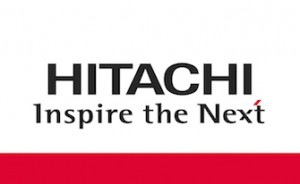 Hitachi, Ltd. (TYO:6501), which is headquartered in Tokyo, is a Japanese conglomerate with an incredibly diversified business portfolio. Various business segments within which Hitachi operates include electronic systems and equipment, automotive systems, telecommunications systems and social infrastructure.
Hitachi, Ltd. (TYO:6501), which is headquartered in Tokyo, is a Japanese conglomerate with an incredibly diversified business portfolio. Various business segments within which Hitachi operates include electronic systems and equipment, automotive systems, telecommunications systems and social infrastructure.
Worldwide, Hitachi supports a large network of research and development facilities, including locations in America, England, India, Singapore, Brazil and China. The company’s R&D mindset maintains a particular focus on social innovation, which the company sees as comprising innovations in healthcare, transportation, water, energy, food and other systems which are important to society. In November of last year, Hitachi announced the upcoming release of six social innovation systems, including a real-time visualization system to aid law enforcement and healthcare data systems. In the fiscal year ending with March 31, 2014, Hitachi spent ¥351.4 billion on R&D, which was 3.7 percent of revenues.
Hitachi’s revenues have grown year over year from ¥7.8 trillion to ¥8.3 trillion, according to their latest financial reports. The company plans to open a train manufacturing facility this year in Durham, England, which will cost about £82 million to build. Hitachi’s construction subsidiary has been dealt with tough economic times lately with its stock value on the Japanese equities index falling by more than 10 percent. Elsewhere, Hitachi Appliances has entered into an agreement with Johnson Controls of Milwaukee, WI, to form a global joint venture for HVAC and refrigeration products. A patent dispute between Hitachi and the China Rare Earth Permanent Industry Development Promotion, a consortium of 16 Chinese companies involved in rare earth mining, could affect half of the world’s rare earth production.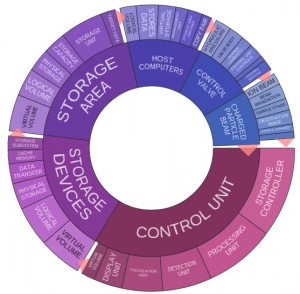
In 2014, Hitachi earned a total of 908 patent grants from the U.S. Patent and Trademark Office, the 38th-largest total of U.S. patents issued to any single entity. When the patent activities of its subsidiaries are taken into account, however, the entire Hitachi Group earned 2,108 U.S. patent grants during 2014, according to our research using Innography patent analytics. As with most of the high tech Companies We Follow, we’re noticing a lot of innovation in control units and data storage devices, as reflected by our research using Innography search tools and represented in the text cluster diagram shown to the right. Hitachi has a very strong patent portfolio in automotive battery tech and even owns more patents in this field than Toyota.
[Companies-1]
Hitachi’s Issued Patents: From Rare Earth Magnets to Pedestrian Recognition Systems
Rare earth metals are the subject of one of Hitachi’s recently issued patents which we took note of today. U.S. Patent No. 8945318, which is titled R-Fe-B Type Rare Earth Sintered Magnet and Process for Production of the Same, discusses an innovation meant to achieve deeper diffusion of rare earth metals within a magnet body to produce a more even coercivity, or resistance to changes in magnetization in a magnetic material, throughout the magnet. This patent claims a rare earth sintered magnet that includes crystal grains of an R2Fe14B compound where R is a rare earth metal such as neodymium or praseodymium. The crystal grains include a heavy rare earth diffused layer measuring 0.5 micrometers (µm) where the heavy rare earth is dysprosium, holmium or terbium.
Automotive innovations spearheaded by Hitachi are among the issued patents that we noticed in our survey of this company’s latest patent-protected innovations. Enhancements to the operating efficiencies of hybrid and electric vehicles as a whole are the result of the innovation outlined within U.S. Patent No. 8909398, issued under the title Cooling System of Electric Vehicle. The cooling system claimed here includes a circulation path through which a cooling medium is circulated to an electrically powered vehicle drive unit, a heat exchange unit that exchanges heat between the cooling medium and the external air, a cooling medium circulation unit for circulating the cooling medium along the path between the drive unit and heat exchange unit, a blower unit that blows air against the heat exchange unit and a control unit that controls both the blower and cooling medium circulation units. Through the use of this cooling system it is possible to reduce the physical size of both the electric motor and inverter power supply while obtaining the same level of torque and output power as conventional electric vehicle systems. Driver assist technologies, an area of much R&D focus 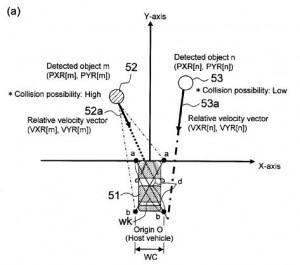 in the automotive world as reported by Thomson Reuters, for the recognition of pedestrians on or near the road is at the center of U.S. Patent No. 8924140, entitled External Environment Recognition Device for Vehicle and Vehicle System Using Same. The patent protects an external environment recognition device for a vehicle that recognizes a vehicle’s external environment based on detected object information of a plurality of objects in front of a host vehicle, image information of an image in front of the host vehicle and a means for setting a predicted course based upon host vehicle information derived from a detected status of a host vehicle. This invention is intended to address delays in processing recognition of pedestrians by reducing the processing load required to detect pedestrians and other obstacles for collision avoidance.
in the automotive world as reported by Thomson Reuters, for the recognition of pedestrians on or near the road is at the center of U.S. Patent No. 8924140, entitled External Environment Recognition Device for Vehicle and Vehicle System Using Same. The patent protects an external environment recognition device for a vehicle that recognizes a vehicle’s external environment based on detected object information of a plurality of objects in front of a host vehicle, image information of an image in front of the host vehicle and a means for setting a predicted course based upon host vehicle information derived from a detected status of a host vehicle. This invention is intended to address delays in processing recognition of pedestrians by reducing the processing load required to detect pedestrians and other obstacles for collision avoidance.
Although Hitachi’s construction business has experienced some woeful days, which we discuss briefly in today’s introduction, we’re still seeing a fair amount of R&D investment into heavy industry technologies. One of these, U.S. Patent No. 8935033, issued under the title Electrically Driven Dump Truck, discusses a dump truck configured to be 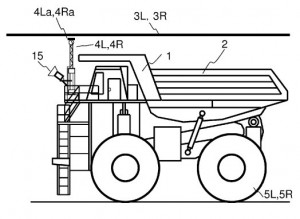 driven from electrical power supplied by trolley wires and not with energy supplied by an engine. This electrically driven vehicle protected by the patent includes a trolley wire detection device for detecting a trolley wire from below while the vehicle is traveling and a control device which controls a yaw moment to the vehicle so that the vehicle travels while tracing the trolley wire. This invention allows a hybrid dump truck to stay in-lane with the trolley wires supplying power to the truck without requiring a human driver to judge whether or not the truck is properly below the trolley wires.
driven from electrical power supplied by trolley wires and not with energy supplied by an engine. This electrically driven vehicle protected by the patent includes a trolley wire detection device for detecting a trolley wire from below while the vehicle is traveling and a control device which controls a yaw moment to the vehicle so that the vehicle travels while tracing the trolley wire. This invention allows a hybrid dump truck to stay in-lane with the trolley wires supplying power to the truck without requiring a human driver to judge whether or not the truck is properly below the trolley wires.
Alternative energy systems for harvesting electricity from natural wind energy is described within U.S. Patent No. 8941257, which is titled Wind Power Generator. The innovation is designed so that internal components of a wind power generator, specifically the brush installed within the nacelle, have better humidity management and are less likely to become worn in response to changes in the environmental humidity surrounding the generator. The wind power generator protected here includes a humidity management device, installed within the nacelle, containing a sensor for measuring the humidity inside a wind power generator as well as a humidifier and a dehumidifier for humidity control of the power generator’s interior in response to sensor measurements.
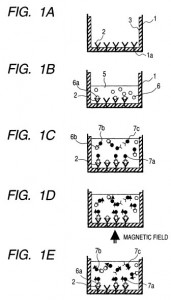 We also took note of a couple of medical innovations brought to the world by Hitachi, one of which is outlined within U.S. Patent No. 8945469, entitled Magnetic Immunoassay System. This patent protects a magnetic immunoassay system which measures a remnant magnetic signal for detecting an antigen contained within a sample; the system utilizes a nonmagnetic reaction chamber with a surface covered with capturing antibodies for binding antigens in a sample, a mechanism for moving the reaction chamber and a magnetic sensor measuring the magnetic signals from the chamber for sending a signal to a processor to detect magnetic particles binding to the group of collected antigens. The resulting immunoassay system has an improved detection sensitivity for detecting DNA, environmental toxins or cancer cells than conventional systems utilizing optical fluorescent enzymes and not magnetic forces.
We also took note of a couple of medical innovations brought to the world by Hitachi, one of which is outlined within U.S. Patent No. 8945469, entitled Magnetic Immunoassay System. This patent protects a magnetic immunoassay system which measures a remnant magnetic signal for detecting an antigen contained within a sample; the system utilizes a nonmagnetic reaction chamber with a surface covered with capturing antibodies for binding antigens in a sample, a mechanism for moving the reaction chamber and a magnetic sensor measuring the magnetic signals from the chamber for sending a signal to a processor to detect magnetic particles binding to the group of collected antigens. The resulting immunoassay system has an improved detection sensitivity for detecting DNA, environmental toxins or cancer cells than conventional systems utilizing optical fluorescent enzymes and not magnetic forces.
Patent Applications of Note: Electric Vehicles, Cloud Computing and Robotics Navigation
Our foray into Hitachi’s recently filed patent applications allowed us to explore some intriguing inventions in alternative energy, such as the technology disclosed by U.S. Patent Application No. 20140363351, which is titled Renewable Energy Conversion and Storage Equipment. The patent application claims renewable energy power generation equipment that generates varying electric power and a water electrolysis device which uses the electric power to produce hydrogen. The system for hydrogen generation utilizes electric energy from renewable sources rather than from fossil fuel to reduce the carbon dioxide gas released during hydrogen productions.
Electric vehicles continue to be a focus of innovation for Hitachi to judge by a pair of patent applications that we explored in further detail today. Wireless charging for electric-powered vehicles is an area of recent automotive development, as we discussed in our 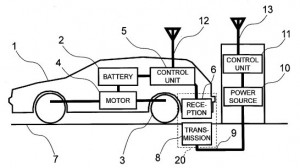 coverage of auto tech from the 2015 Consumer Electronics Show, and Hitachi has its own entry into this sector with U.S. Patent Application No. 20150002091, filed under the title Wireless Charging System. The wireless charging system claimed here includes multiple winding portions formed by winding an electric wire and sandwiched together with the use of a pair of magnetic members. This wireless charging system configuration achieves an improved charging efficiency resulting from an increased coefficient of magnetic coupling between a transmitting unit and a receiving unit during wireless charging. An improved configuration for a power conversion apparatus used by an electric vehicle is the subject of U.S. Patent Application No. 20150022974, which is titled Power Conversion Apparatus and Electric Vehicle. The power converter apparatus claimed here includes a power module with a power semiconductor element, a driving circuit board that drives the power semiconductor element, a control circuit board that controls the semiconductor element and a metal base disposed between the driving and control circuit boards. This invention includes a cooling jacket and heat releasing parts that provides adequate cooling while reducing the dimensional size and manufacturing costs of the power converter apparatus.
coverage of auto tech from the 2015 Consumer Electronics Show, and Hitachi has its own entry into this sector with U.S. Patent Application No. 20150002091, filed under the title Wireless Charging System. The wireless charging system claimed here includes multiple winding portions formed by winding an electric wire and sandwiched together with the use of a pair of magnetic members. This wireless charging system configuration achieves an improved charging efficiency resulting from an increased coefficient of magnetic coupling between a transmitting unit and a receiving unit during wireless charging. An improved configuration for a power conversion apparatus used by an electric vehicle is the subject of U.S. Patent Application No. 20150022974, which is titled Power Conversion Apparatus and Electric Vehicle. The power converter apparatus claimed here includes a power module with a power semiconductor element, a driving circuit board that drives the power semiconductor element, a control circuit board that controls the semiconductor element and a metal base disposed between the driving and control circuit boards. This invention includes a cooling jacket and heat releasing parts that provides adequate cooling while reducing the dimensional size and manufacturing costs of the power converter apparatus.
Cloud computing innovations are always popular among readers of the Companies We Follow series and we found Hitachi supporting some development in this field with the filing of U.S. Patent Application No. 20150026342, entitled Virtual Resource Management Tool for Cloud Computing Service. This patent application would protect a method for allocating software resources by receiving tasks requiring at least one software resource from a network, analyzing each task to determine the type of resource required to execute each task, determining the availability of those resources and either allocating those resources for the task or repeating the analysis step until resources are available. This invention achieves the objective of allocating software resources in a multiuser system, such as a cloud server, in an efficient manner and providing a wait queue when one individual attempts to connect to a software resource which is already being used.
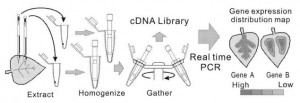 Improved methods of analysis for identifying gene expressions within plant tissue have also been developed by Hitachi and are the focus of U.S. Patent Application No. 20150018243, which is titled Plant Tissue Sampling Method and Plant Gene Analysis Method. The innovation is designed to enable a system through which a fragment of plant tissue can be quickly sampled and the gene expression state within the tissue fragment is quickly preserved for comprehensive analysis. This Hitachi patent application would protect a method of sampling a plant tissue section involving the steps of inserting a first gel layer into a needle, arranging a plant tissue on a second gel layer, passing the needle through the plant tissue and second gel layer and sampling a section of plant tissue in the needle.
Improved methods of analysis for identifying gene expressions within plant tissue have also been developed by Hitachi and are the focus of U.S. Patent Application No. 20150018243, which is titled Plant Tissue Sampling Method and Plant Gene Analysis Method. The innovation is designed to enable a system through which a fragment of plant tissue can be quickly sampled and the gene expression state within the tissue fragment is quickly preserved for comprehensive analysis. This Hitachi patent application would protect a method of sampling a plant tissue section involving the steps of inserting a first gel layer into a needle, arranging a plant tissue on a second gel layer, passing the needle through the plant tissue and second gel layer and sampling a section of plant tissue in the needle.
 The Hitachi mindset of “social innovation” is clearly on display in the public health technology that would be protected by U.S. Patent Application No. 20150010902, entitled Apparatus and Method for Monitoring Airborne Microorganisms in the Atmosphere. This invention is intended to aid in the detection of airborne pathogens, like influenza, directly from the atmosphere and works both continuously and in a short period of time. The patent application claims an apparatus for monitoring airborne microorganisms including a chassis with a fan for flowing air towards an interior segment, a perforated plate disposed at the chassis with multiple nozzles for focusing split air flows, a capturing plate with a plurality of trapping surfaces and an optical detection part for fluorescence generated from the microorganisms on the capturing plate’s trapping surfaces.
The Hitachi mindset of “social innovation” is clearly on display in the public health technology that would be protected by U.S. Patent Application No. 20150010902, entitled Apparatus and Method for Monitoring Airborne Microorganisms in the Atmosphere. This invention is intended to aid in the detection of airborne pathogens, like influenza, directly from the atmosphere and works both continuously and in a short period of time. The patent application claims an apparatus for monitoring airborne microorganisms including a chassis with a fan for flowing air towards an interior segment, a perforated plate disposed at the chassis with multiple nozzles for focusing split air flows, a capturing plate with a plurality of trapping surfaces and an optical detection part for fluorescence generated from the microorganisms on the capturing plate’s trapping surfaces.
Finally, we took note of an interesting system for determining the potential moving directions of individuals who are not moving, which is outlined within U.S. Patent Application No. 20140376780, filed under the title Method for Estimating Direction of Person Standing Still. The patent application claims a method that involves detecting a boundary position between a person’s foot and lower leg through an imaging unit, detecting a feature quantity which makes it possible to classify a ground and image parts other than the ground and setting a plurality of local regions having positional and/or directional information relative to the boundary position. As a perusal of the summary of invention section of this patent application will show our readers, this system is designed for use with an autonomous mobile apparatus, such as a robot, and provides the mobile robot with a means for effectively navigating a crowded environment without getting into the potential path of people standing still who could start walking at any time.

![[IPWatchdog Logo]](https://ipwatchdog.com/wp-content/themes/IPWatchdog%20-%202023/assets/images/temp/logo-small@2x.png)

![[Advertisement]](https://ipwatchdog.com/wp-content/uploads/2024/04/Artificial-Intelligence-2024-REPLAY-sidebar-700x500-corrected.jpg)
![[Advertisement]](https://ipwatchdog.com/wp-content/uploads/2024/04/UnitedLex-May-2-2024-sidebar-700x500-1.jpg)
![[Advertisement]](https://ipwatchdog.com/wp-content/uploads/2024/04/Patent-Litigation-Masters-2024-sidebar-700x500-1.jpg)

![[Advertisement]](https://ipwatchdog.com/wp-content/uploads/2021/12/WEBINAR-336-x-280-px.png)
![[Advertisement]](https://ipwatchdog.com/wp-content/uploads/2021/12/2021-Patent-Practice-on-Demand-recorded-Feb-2021-336-x-280.jpg)
![[Advertisement]](https://ipwatchdog.com/wp-content/uploads/2021/12/Ad-4-The-Invent-Patent-System™.png)






Join the Discussion
No comments yet.